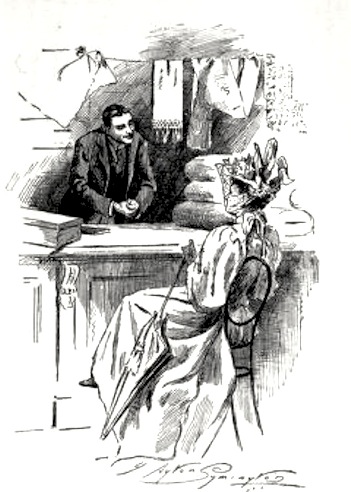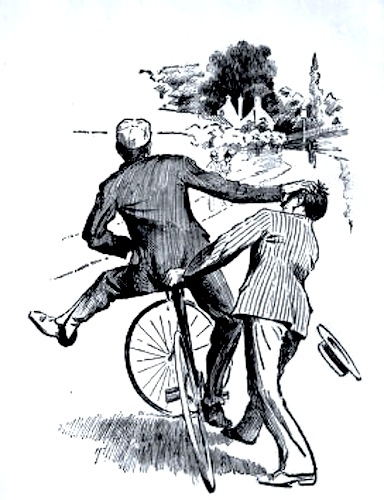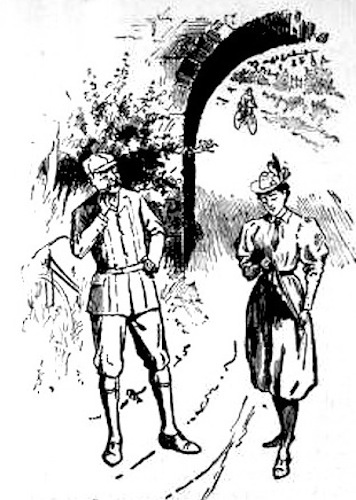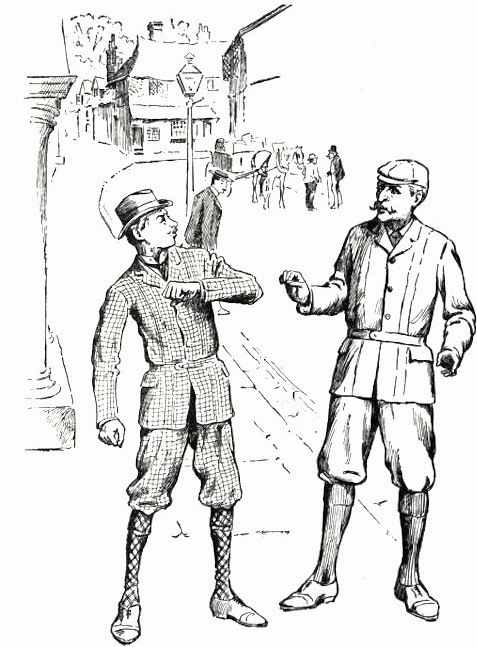Adapted by the author from Chapter 8 of her book, Literary Surrey (Headley Down: John Owen Smith, 2005), and illustrated with scans from Project Gutenberg and the Internet Archive, and one of her own photographs. You may use these images without prior permission for any scholarly or educational purpose as long as you (1) credit the source and (2) link your document to this URL or cite the Victorian Web in a print one. [Click on all the images to enlarge them.]

"Cycling," H. G. Wells, Experiment, 459.
From its year of publication, and from what Wells himself says in the chapter of his autobiographical Experiment entitled "Lynton, Station Road, Woking (1895)," the first of his novels to be planned, fully written and completed in Surrey was The Wheels of Chance. Subtitled "A Bicycling Idyll," it reflects the new and more rural context in which he now found himself.
In Woking, the opportunities for open-air pursuits lay right on his doorstep. Boating on the quiet stretch of the nearby Basingstoke Canal was easy enough. Cycling, however, was an art which Wells took some time to master. In those days, he reminds us, bikes could not freewheel, and the brakes were poor. In Chapter 4 of his later and much-loved novel, Kipps (1909), he describes the sort of emergency that could result. Here, a would-be playwright called Harry Chitterlow bumps into Kipps and sends him flying despite the most desperate efforts to stop: "I was back-pedalling for all I was worth," explains Chitterlow in Chapter 4. "Not that I am worth much back-pedalling" (67). Wells is probably recalling his own experience as an learner-cyclist. But in real life he soon became more competent than Chitterlow, and had a strange-looking tandem made with handlebars in the middle, on which he could take Jane safely all over the countryside. Quite an achievement, considering that he had to steer the bike from behind his passenger, who can be seen in one photograph wearing fashionable puffed sleeves and a wide-brimmed hat!
One of his light-hearted little sketches of that time (which he dubbed "picshuas") shows the couple setting off from Lynton bright and early on a summer's day, sheltering from the rain an hour later, out on the Aldershot road soon afterwards, at Farnham in another fifteen minutes, and finally sitting in a field beyond Alton, having a rest, before 11 a.m. This particular trip, he says, took them eventually as far as Cornwall. That might seem a very long expedition, especially for someone with a bad chest. But, as Wells points out himself with his usual enthusiasm, it was simply the best way to travel then: "the bicycle was the swiftest thing upon the roads in those days, there were as yet no automobiles, and the cyclist had a lordliness, a sense of masterful adventure, that has gone from him altogether now" (Experiment, 458).

Mr Hoopdriver as an ingratiating draper's-shop assistant (by J. Ayton Symington, The Wheels of Chance, 3).
Not unexpectedly, in view of that long and varied cross-country journey, The Wheels of Chance is a picaresque romance which is in various ways a precursor to Kipps. The hero is the aptly named Mr Hoopdriver, an apprentice draper as Wells himself had once been. Unbeknown to the refined ladies he serves, Hoopdriver already harbours numerous bumps and bruises on his body as a result of many bicycling mishaps, evidently reflecting the author's own crashes and tumbles: "I rode wherever Mr Hoopdriver rode in that story," Wells recalled (458). Amusing, charming and hopeful, the whole novel draws heavily on those early experiences in the bicycle saddle, and because of its topographical accuracy is quite irresistible to anyone familiar with this part of southern England.
Hoopdriver is an altogether Wellsian figure. Despite the battering he has already taken, and the blisters on his hands from much urgent clutching at the brakes, he is full of high spirits, and sets off from his home in Putney on an ambitious cycling holiday to the south coast. At first he proceeds with great difficulty, and then with more confidence. As he sails past another draper's shop in Kingston in Chapter 4, he is already glorying in his freedom. Then on he goes to Guildford, via Surbiton, Esher, and "a charming little place between Esher and Cobham, where a bridge crosses a stream" (47-49) — West End, Esher, surely. Chapter 9 finds him in Guildford, where he notes the geraniums round the castle, and pays 2p. to go up the Keep of "the old bramble-bearing, fern-beset ruin," thoroughly enjoying the view across "the waves of blue upland that rose, one behind another, across the Weald, to the hazy altitudes of Hindhead and Butser" (65; Butser Hill is beyond Hindhead, over the border in Hampshire). Soon, Hoopdriver is on the road again.




(a) Hoopdriver's friend is endangered by Hoopdriver's poor balance at the beginning (by Symington, The Wheels of Chance, 8). (b) Guildford Castle now, no longer "bramble-bearing, fern-beset" (65). (c) Jessie Milton and the Bounder (by Symington, The Wheels of Chance, 86). (d) Hoopdriver encounters the "bounder" — a Mr. Bechamel, who mistakes him for a detective, much to Hoopdriver's indignation (by Symington, The Wheels of Chance, 114).
On his way, Hoopdriver has various encounters, and manages to save a young woman called Jessie Milton from a "bounder." The romantic attachment finally comes to an end at Stoney Cross in the New Forest. After all, Jessie is a middle-class girl, quite above him in station (another typically Wellsian touch). The rejected hero then makes his way back to Putney alone, via Basingstoke, at the end of the last chapter. However, he is not miserable. On the contrary, he has a great sense of new possibilities — "wonderful memories and still more wonderful desires and ambitions" (321). The whole novel is an unambiguous expression of Wells's own hopes and aspirations, along with his delight in being let loose at last in the open air amid the beauties of nature. The delight is unaffected and infectious, and very different in those respects from the "scientific romances" of this period, such as The Time Machine (1895) and The War of the Worlds (1897).
Does The Wheels of Chance do any more than give us some light relief — "an agreeable respite from monsters" (Mackenzie 126)? Or simply provide us with a "rich variety of credible quotidian characters" in the realist tradition (Warren Wagar 15)? Without claiming any great profundity for it, we can still acknowledge the way it captures the flavour of youth, and the flavour, too, of the late-Victorian period. This was not the fin-de-siécle decadence of sophisticated high culture, and had nothing to do with what we might call high-end escapism into a rarified aestheticism. It was just the time in ordinary people's lives when change was in the air. This was usefully exemplified by the bicycle. It ruled the road, or at least the lanes, and was giving a new freedom to the middle and lower classes, opening up wonderful new opportunities for exploring the countryside.
More importantly for Wells's writing career, The Wheels of Chance was also a step towards Love and Mr Lewisham (1900), which is generally seen as his first excursion into realistic fiction, and which he had, in fact, already started in Woking. Kipps, which he worked on for several years before it took its final shape, would develop this thread of his work, as would The History of Mr Polly (1910). But it would find its best expression in the marvellous Tono-Bungay (1909, but serialised from 1908). In all these, but in Tono-Bungay especially, he would fuse memories of his own bumps and joltings in youth and early manhood with his more mature vision, so that an often humourous narrative also expressed his criticism of society — and his worries about where it was heading. Wells's importance in the field of science fiction tends to overshadow these works. They are, after all, not ground-breaking technically. Indeed, they have much in common with the picaresque novels of the eighteenth century. But they are still highly individualistic, and in that way make a unique contribution to the late-Victorian and early twentieth-century novel.
Related Material
- Punch on "New Regulations for the Safety of Bicyclists."
- Punch on "The Bicycle Suit" (for women)
- Victorian Fashion and the Growth of Sporting Activities, 1850-1900
Sources
Mackenzie, Norman & Jeanne. The Time Traveller: The Life of H. G. Wells. London: Weidenfeld & Nicolson, 1973.
Wagar, W. Warren. H. G. Wells: Traversing Time. Middletown, Connecticut: Wesleyan University Press, 2004.
Wells, H. G. Experiment in Autobiography: Discoveries and Conclusions of a Very Ordinary Brain (Since 1866). Philadelphia and New York: J. B. Lippincott, 1967. Project Gutenberg. Produced by Chuck Greif & the Online Distributed Proofreading Team at http://www.pgdpcanada.net. Web. 13 January 2016.
_____. Kipps. London: Penguin Classics, 2005.
_____. The Wheels of Chance: A Bicycling Idyll, with illustrations by J. Ayton Symington. New York: Macmillan, 1913. Internet Archive. Contributed by Kelly — University of Toronto. Web. 13 January 2016.
Last modified 13 January 2016